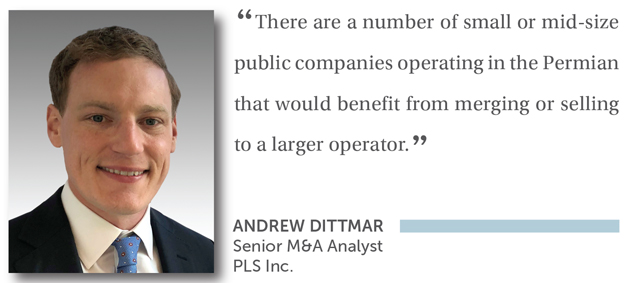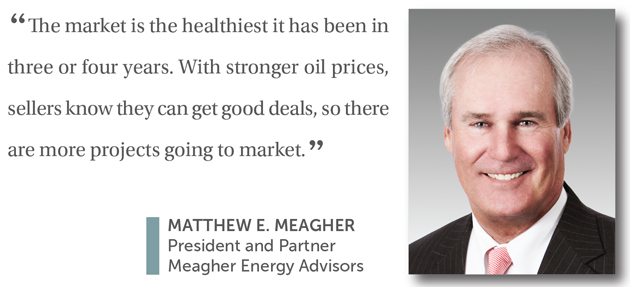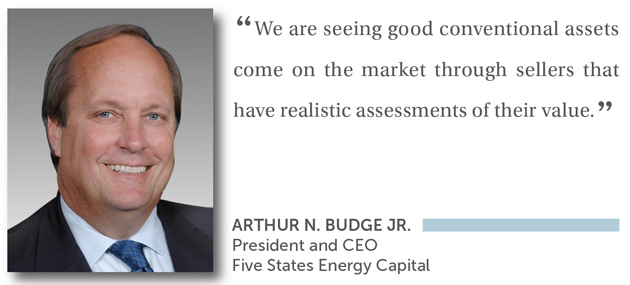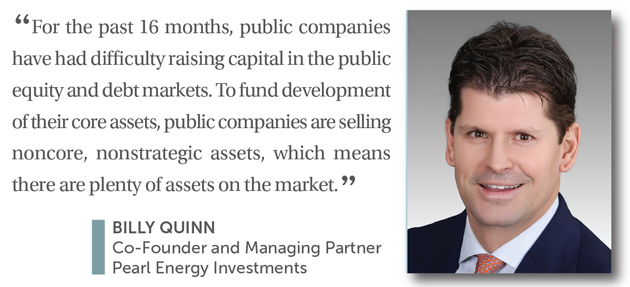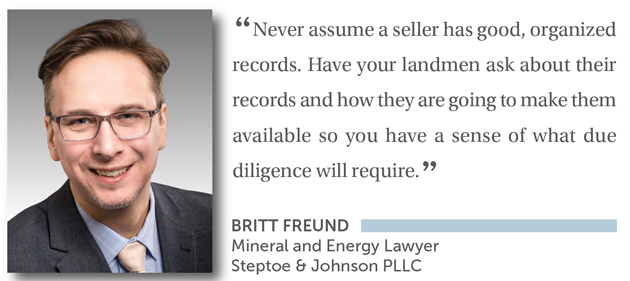
Pure Play Strategies, Quality Assets Add to M&A Opportunities
By Colter Cookson
While the first quarter of 2018 was winding down and crude prices were approaching the mid-$60s, Concho Resources Inc. announced the biggest oil and gas deal in the United States in years and the biggest ever in the Permian Basin: the acquisition of RSP Permian in an all-stock transaction valued at $9.5 billion.
Notably, Concho says the transaction, which it expects to close in the third quarter, gives it the largest drilling and completion program in the Permian with 27 rigs deployed. When the deal was announced in late March, Concho Chief Executive Officer Tim Leach touted the value of RSP’s 92,000-acre leasehold, saying that once incorporated into Concho’s inventory, the mostly contiguous acres are likely to move to the front of Concho’s development queue in its new total Permian position of 640,000 acres.
Location, location, location. The old real estate adage applies to oil and gas deal making like never before. It is certainly a key part of Concho’s deal, according to Leach and RSP Permian CEO Steven Gray. The desire to build contiguous acreage blocks is creating a healthy environment for strategic company and property
acquisitions many analysts say will persist as long as oil prices remain robust.
Of course, the Permian became the Park Avenue of oil and gas properties as oil prices rebounded, giving companies with acreage and capital the ability to turn their attention to full-field development of stacked tight oil zones.
“Our size, scale and execution strength provide us with the unique ability to capitalize on complementary assets,“ Leach asserts. He says the two companies’ operational and corporate synergies, such as their increased ability to optimize development of their combined assets by drilling long laterals and sharing infrastructure, are worth more than $2 billion to its stakeholders.
There is more to the story of contiguous acreage than cost savings, according to Leach. Specifically, he notes that the combined asset inventory also minimizes parent/child locations.
The market initially gave thumbs up to RSP Permian, and analysts are quick to suggest that if oil prices continue to trend upward, it will be an even bigger win for all shareholders. Raymond James has maintained its buy rating on Concho. The Raymond James first-quarter 2018 earnings reports reiterated its “strong buy” in place for multiple years, according to Graham Price, senior exploration and production equity research associate. In that note, the firm also reiterated its target price of $246 a share.
Concho’s Leach says the deal makes sense as both companies–and the Permian as a whole–transition to intense development. “The efficiency we can gain through a bigger balance sheet and a bigger program is driving this transaction,” he summarizes.
RSP CEO Gray echoes that sentiment. “As RSP has grown and we have seen the resource play develop, we have come to recognize that combining with a company with the scale, investment-grade balance sheet and operational excellence of Concho will unlock even more value for shareholders. The combined company will have the vision and necessary financial strength to efficiently develop the tremendous resource potential of these assets with large-scale projects,” he concludes.
Consolidations To Come
The Concho/RSP merger is but the first of many consolidations likely to occur in the Permian Basin, predicts Andrew Dittmar, a senior merger and acquisition analyst at PLS Inc., a Houston-based transaction adviser that tracks energy-related acquisitions and divestitures.
“There are a number of small or mid-size public companies operating in the Permian that would benefit from merging or selling to a larger operator,” he says. “As larger companies, they may be able to negotiate better deals with service providers and get more access to infrastructure. But the primary benefit is getting big, blocky chunks of acreage where they can drill 10,000 foot laterals, then walk the rig 660 feet and drill another as part of a continuous development program.”
In addition to looking at possible mergers, operators are engaging in small-scale trades and bolt-on acquisitions to create acreage blocks, Dittmar reports.
“There is a drive for companies to become ‘pure plays,’” he says. “In the past, the stock markets favored diversified portfolios, but today they want companies to focus on one or two regions. It is easier for the more focused companies–especially those in top-tier basins such as the Permian–to live within cash flow and allocate capital efficiently.”
Capital efficiency has become key for public companies, Dittmar observes. “At the Oil & Gas Investment Symposium in April, almost every company pointed out that its executives’ compensation was tied to shareholder return metrics rather than growth,” he reports. “Investors no longer want to see growth for growth’s sake. Growth still occurs, but only as part of the puzzle for shareholder returns.”
As companies look to become pure plays, they have put noncore assets on the market, Dittmar notes. A case in point is Pioneer Natural Resources, which has announced plans to sell its Eagle Ford, Raton Basin and Texas Panhandle assets to become a Permian Basin pure play.
Including the $9.5 billion merger between Concho and RSP, Dittmar says the upstream industry conducted $21 billion in deals during the first quarter. “If we take out that merger, activity is in line with the past few quarters. The market is active, but not to the extent we saw in late 2016 or 2017, when there was a rush to acquire proven assets in the Permian,” he allows.
“In most mature plays, such as the Eagle Ford and Bakken, there are more companies looking to shed noncore assets than there are logical buyers for those assets,” Dittmar assesses. “The public companies in those plays have large enough positions that they are comfortable with their portfolios and mostly are not looking to expand them. That is making private-equity-backed companies cautious about deploying capital there, since their exit strategy often involves a sale to the public companies.”
In theory, private companies could generate the high returns their backers require through initial public offerings. However, even with oil prices in the $60-$70 range, many investors are wary of the upstream segment, Dittmar indicates.
When deals occur, Dittmar says the prices tend to be reasonable. “Sellers have an incentive to divest assets so they can allocate capital to higher-return plays, but their balance sheets are strong enough that they can wait for deals that work for both parties,” he explains.
Marketing Assets
With oil prices trending upward, now is good time to sell assets, asserts Matthew E. Meagher, president and partner at Meagher Energy Advisors, an M&A advisory firm with offices in Denver and Tulsa. “The market is the healthiest it has been in three or four years,” he declares. “With stronger oil prices, sellers know they can get good deals, so there are more projects going to market.”
Interest in quality projects is high, he adds. “We are seeing 20-50 companies order data for most projects we take to market, and 15 percent of the companies that order data make offers,” Meagher details. “The interest is there, in part because there are a lot of private-equity-backed teams trying to find their first assets.”
The Permian Basin, SCOOP/STACK, Niobrara and Powder River Basin have been particularly active, Meagher says.
Companies that want to sell an asset need to supply its details in a digestible form, Meagher advises. “We often see sellers come forward with incomplete data. They often have solid land and geologic records, but incomplete lease operating statements,” he says.
According to Meagher, a lease operating statement should include a well list with each well’s name, location and API number, as well as details on its production, including monthly and yearly totals. “That information is important for doing reserves analysis,” he explains.
It sometimes makes sense to market small assets through a bare-bones listing service, but for larger assets or ones where upside value needs to be realized, Meagher recommends partnering with an advisory firm. In addition to helping the seller get data into shape, he says the best firms will identify potential upside and target buyers, then pitch the asset to them.
“Ideally, sellers should partner with an adviser that has engineers, geologists and landmen on staff, as well as experience in the basin. The adviser needs to have the ability to research specific properties, identify where the value is and communicate that value to potential buyers,” Meagher says.
Before agreeing to market an asset, advisers generally look at it closely. “We turn down more projects than we accept,” Meagher cautions. “Before we spend time marketing an asset, we want to make sure it has a reasonable quantity of potential buyers. It’s also important for us to know that the seller is sincere about divesting the asset and has reasonable expectations about its value.”
For buyers, Meagher emphasizes the importance of securing financing ahead of a deal. “It takes work to find the right deal. In fact, a buyer may look at 50 projects and find only one or two packages that are a good fit,” he says. “At that point, a buyer that can show it has the ability to close and put down a deposit quickly will stand out from teams that are not financed.”
Capital Discipline
It is a fantastic time to put private equity to work in the upstream oil and gas space, assesses Arthur N. Budge Jr., president and CEO of Five States Energy Capital, a Dallas-based private equity firm. “This is the best market we have seen in a decade,” he assesses. “The senior lenders and private equity providers that remain in the space have adopted a more disciplined approach to valuing acquisition and development transactions.”
When oil activity was at its height, Budge recalls, Five States would see bids on assets two or three times higher than its own. He credits those bids to capital providers that would underestimate development cost inflation and do discounted cash flow analyses with unrealistically low discount rates, or assume oil prices would remain at or above $85 a barrel. “Today, people are far more realistic,” he says.
That is reflected in the quality of the proposals the firm receives. “Five years ago, when capital was being undervalued and assets overvalued, it seemed everyone was trying to sell plugging liabilities to someone else,” Budge recalls. “Now we are seeing good conventional assets come on the market through sellers that have realistic assessments of their value.”
According to Budge, Five States prefers to invest in conventional assets. “There is a high degree of uncertainty in short-term oil prices, so we hedge aggressively when we acquire production. Because conventional assets’ production has a half-life of six or seven years rather than one or two, we can hedge 70-80 percent of the production for the first three or four years, but still have plenty of unhedged production and upside potential in the long term,” he explains.
Unlike many private equity firms, Budge continues, Five States is a long-term investor. “While we are not opposed to exiting in three-five years, it is not a requirement for us,” he says. “We are in the business to own oil and gas assets, and have held many for 10, 15 or 30 years. We take the long view because we know production on long-lived, high-quality properties tends to go up as operators do infill drilling, complete zones that were previously skipped, and apply new technologies.”
Budge says the firm’s long-term view means it can consider opportunities with modest short-term returns but impressive total returns, and be more flexible with regard to deal structures.
Private equity firms get far more submissions than they can review in detail. “In good years and bad, Five States sees 400-500 submittals,” Budge reports. “Half come from boiler rooms in New York and Los Angeles, and quickly get discarded. Of the ones that remain, only 150-200 warrant some type of review, and we focus on 50-75 each year.”
The key to getting a thorough review is to present a compelling opportunity in good faith, Budge says. “Be realistic in your teaser and your assumptions,” he stresses. “We are far more likely to trust and work with someone who comes in with realistic price differentials and expenses that are easy to tie to the lease operating statements.”
Institutional Appetite
Because upstream oil and gas investments can offer differentiated returns, especially early in the development cycle, institutional investors are willing to commit to small and mid-sized private equity funds, reports Billy Quinn, a founder and managing partner at Pearl Energy Investments.
As proof, Quinn cites Pearl’s second fund, which opened in May 2017 and closed in July 2017 at its cap of $600 million. He says the fund’s success–and that of a few others launched by well-led firms–reflects the strong institutional desire to put capital into the upstream sector.
“For the past 16 months, public companies have had difficulty raising capital in the public equity and debt markets,” Quinn observes. “To fund development of their core assets, public companies are selling noncore, nonstrategic assets, which means there are plenty of assets on the market.”
Many of those assets are worth owning with the right management team, Quinn assures. “It helps that there is backwardation in the price curve,” he comments. “We have seen near-month oil prices exceed $70 a barrel, but five years out, the curve is at $55. At that curve, there is a tight spread between what sellers expect to get and what buyers can pay.”
Pearl tends to back teams seeking $25 million-$75 million in capital. “We look for great teams that have expertise in a particular niche,” Quinn says. “Half of our teams are unconventional and the other half focus on conventional assets. Geographically, we have a heavy bias toward Texas, Oklahoma, Louisiana, New Mexico and the Rocky Mountains.”
As of early May, the firm had 10 teams in its portfolio. While Quinn says he expects that count to grow, it is unlikely to exceed 15 companies. “We want to provide management teams with as much of our time as possible so we can help them build successful companies,” he explains. “When they call looking for advice or needing a quick decision, we want to be accessible.”
Quinn encourages management teams to tap their backers’ expertise. “Ninety percent of the time, the issues portfolio companies go through happen to all startups,” he says. “We have seen similar issues hundreds of times and have other portfolio companies going through different variations of the same issue, so we can offer advice based on experience.”
He mentions staffing as an example of a hurdle common to many new companies. “As a startup is closing its first deal, it may need to hire six, seven or more people to manage the asset. These hires need to be capable and a great fit for the team,” Quinn says. “Often, teams will narrow their list of candidates for key positions to two or three people, then ask us for help interviewing. On occasion, our experience lets us see warning signs they may miss.”
Before approaching private equity companies, Quinn says management teams should spend time talking among themselves about what makes them unique. “Think through the critical components of running the business, make sure the team has the skills and fortitude to do it, and talk about who will do what,” he adds. “These are basic questions. Knowing the team has thought about them will reassure potential backers it is serious about launching a business.”
A sound business plan, technical expertise and a track record are not enough to stand out, Quinn cautions. “At least one or two people on the team need an entrepreneurial and capitalistic instinct,” he says. “By that, I mean people who ask themselves not only how they can build and grow a company, but also how they can do it profitably. Ultimately, we have the capital to fund their efforts only because we make our limited partners money.”
Private equity backers also want to see passion, Quinn continues. “Even for people who have done it three or four times, building a company is hard work,” he says. “It takes someone who gets up in the morning and looks forward to his or her day, rather than viewing it as work.”
Management teams should be selective when choosing financial partners, Quinn comments. “The team is going to be working with its private equity partner day in and day out, so it should find people the members like, and who see the world in a similar way,” he elaborates.
They should also check references to make sure everything they are being told is true, Quinn mentions, adding that some of the references should be people who have disagreed with their backers. “With every company, there will be decision points where people do not see 100 percent eye to eye. Partner with someone who will think through and resolve issues collaboratively,” he suggests.
Due Diligence
Conducting due diligence for an acquisition often means prioritizing competing values, according to Britt Freund, a lawyer with Steptoe & Johnson PLLC, which has energy practices in Ohio, Pennsylvania, West Virginia, Kentucky, Texas and Colorado. “The buyer wants to make sure it is getting what it paid for, but it needs to balance being thorough with the reality that due diligence takes time. If the sell process is competitive, buyers may limit due diligence to close more quickly,” he says.
Longer laterals have increased the importance of considering others’ rights during due diligence, Freund warns. “In West Virginia, for example, the due diligence team needs to make sure coal operators’ rights are compatible with extensive oil and gas development,” he illustrates. “If an asset is near coal mines, including mines that have been planned and permitted but not developed, the coal company and the producer will need to reach an agreement governing development, if one is not already in place.”
Freund recommends getting local council involved in due diligence. “There are meaningful differences from area to area,” he elaborates. “For example, because their topography varies, West Virginia and Ohio differ in how real property is described and how oil and gas development has occurred in terms of spacing and unit layout.
“There also are nuances in how leases and other conveyance instruments are structured,” he continues. “Local counsel will know how provisions have been treated and what is understood and implied in the area, which is key to identifying potential title pitfalls.”
In the context of purchasing and selling leases that are held by production, Freund cautions that plugging liability varies from county to county. “A buyer needs to make sure he understands the plugging liability associated with the acquisition and includes it in his economic equation,” he says.
As they negotiate purchase and sale agreements, Freund encourages producers to push for clear language. “Sometimes we see agreements that define a title defect as ‘what a reasonable party would consider a title encumbrance,’ or something along those lines, which is too vague to be useful for resolving disagreements about defects that come up,” he says.
Although buyers should have access to sellers’ land records, Freund says they need to keep in mind that a seller is almost certain to have a different approach to evaluating risk, papering transactions and keeping records. “Never assume a seller has good, organized records,” he urges. “Have your landmen ask about their records and how they are going to make them available so you have a sense of what due diligence will require.”
Sellers should resist the temptation to cover up blemishes or warts in the assets by making information difficult to retrieve, Freund advises. “If the due diligence team members have been around the block, they will spot potential issues. It is much better for them to have information about those issues so they can accurately quantify the risk for their client. The more uncertainty they have, the more likely they are to exaggerate the risk, which could affect the price the buyer is willing to pay.”
For other great articles about exploration, drilling, completions and production, subscribe to The American Oil & Gas Reporter and bookmark www.aogr.com.














